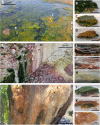Differences in Temperature and Water Chemistry Shape Distinct Diversity Patterns in Thermophilic Microbial Communities
- PMID: 28821552
- PMCID: PMC5648903
- DOI: 10.1128/AEM.01363-17
Differences in Temperature and Water Chemistry Shape Distinct Diversity Patterns in Thermophilic Microbial Communities
Abstract
This report describes the biodiversity and ecology of microbial mats developed in thermal gradients (20 to 65°C) in the surroundings of three drillings (Chiraleu [CH], Ciocaia [CI], and Mihai Bravu [MB]) tapping a hyperthermal aquifer in Romania. Using a metabarcoding approach, 16S rRNA genes were sequenced from both DNA and RNA transcripts (cDNA) and compared. The relationships between the microbial diversity and the physicochemical factors were explored. Additionally, the cDNA data were used for in silico functionality predictions, bringing new insights into the functional potential and dynamics of these communities. The results showed that each hot spring determined the formation of distinct microbial communities. In the CH mats (40 to 53°C), the abundance of Cyanobacteria decreased with temperature, opposite to those of Chloroflexi and ProteobacteriaEctothiorhodospira, Oscillatoria, and methanogenic archaea dominated the CI communities (20 to 65°C), while the MB microbial mats (53 to 65°C) were mainly composed of Chloroflexi, Hydrogenophilus, Thermi, and Aquificae Alpha-diversity was negatively correlated with the increase in water temperature, while beta-diversity was shaped in each hot spring by the unique combination of physicochemical parameters, regardless of the type of nucleic acid analyzed (DNA versus cDNA). The rank correlation analysis revealed a unique model that associated environmental data with community composition, consisting in the combined effect of Na+, K+, HCO3-, and PO43- concentrations, together with temperature and electrical conductivity. These factors seem to determine the grouping of samples according to location, rather than with the similarities in thermal regimes, showing that other parameters beside temperature are significant drivers of biodiversity.IMPORTANCE Hot spring microbial mats represent a remarkable manifestation of life on Earth and have been intensively studied for decades. Moreover, as hot spring areas are isolated and have a limited exchange of organisms, nutrients, and energy with the surrounding environments, hot spring microbial communities can be used in model studies to elucidate the colonizing potential within extreme settings. Thus, they are of great importance in evolutionary biology, microbial ecology, and exobiology. In spite of all the efforts that have been made, the current understanding of the influence of temperature and water chemistry on the microbial community composition, diversity, and abundance in microbial mats is limited. In this study, the composition and diversity of microbial communities developed in thermal gradients in the vicinity of three hot springs from Romania were investigated, each having particular physicochemical characteristics. Our results expose new factors that could determine the formation of these ecosystems, expanding the current knowledge in this regard.
Keywords: hot spring; metabarcoding; microbial diversity; microbial ecology.
Copyright © 2017 American Society for Microbiology.
Figures






Similar articles
-
Biodiversity of the microbial mat of the Garga hot spring.BMC Evol Biol. 2017 Dec 28;17(Suppl 2):254. doi: 10.1186/s12862-017-1106-9. BMC Evol Biol. 2017. PMID: 29297382 Free PMC article.
-
Bacteria and Archaea diversity within the hot springs of Lake Magadi and Little Magadi in Kenya.BMC Microbiol. 2016 Jul 7;16(1):136. doi: 10.1186/s12866-016-0748-x. BMC Microbiol. 2016. PMID: 27388368 Free PMC article.
-
Diversity of phototrophic bacteria in microbial mats from Arctic hot springs (Greenland).Environ Microbiol. 2007 Jan;9(1):26-38. doi: 10.1111/j.1462-2920.2006.01103.x. Environ Microbiol. 2007. PMID: 17227409
-
A natural view of microbial biodiversity within hot spring cyanobacterial mat communities.Microbiol Mol Biol Rev. 1998 Dec;62(4):1353-70. doi: 10.1128/MMBR.62.4.1353-1370.1998. Microbiol Mol Biol Rev. 1998. PMID: 9841675 Free PMC article. Review.
-
Molecular ecology of microbial mats.FEMS Microbiol Ecol. 2014 Nov;90(2):335-50. doi: 10.1111/1574-6941.12408. Epub 2014 Aug 28. FEMS Microbiol Ecol. 2014. PMID: 25109247 Review.
Cited by
-
Temperature-controlled thermophilic bacterial communities in hot springs of western Sichuan, China.BMC Microbiol. 2018 Oct 17;18(1):134. doi: 10.1186/s12866-018-1271-z. BMC Microbiol. 2018. PMID: 30332987 Free PMC article.
-
Comparative Metagenomic Analysis of Two Hot Springs From Ourense (Northwestern Spain) and Others Worldwide.Front Microbiol. 2021 Nov 26;12:769065. doi: 10.3389/fmicb.2021.769065. eCollection 2021. Front Microbiol. 2021. PMID: 34899652 Free PMC article.
-
Bacterial diversity along the geothermal gradients: insights from the high-altitude Himalayan hot spring habitats of Sikkim.Curr Res Microb Sci. 2024 Nov 7;7:100310. doi: 10.1016/j.crmicr.2024.100310. eCollection 2024. Curr Res Microb Sci. 2024. PMID: 39629478 Free PMC article.
-
Mud volcanoes and the presence of PAHs.Sci Rep. 2020 Jan 27;10(1):1253. doi: 10.1038/s41598-020-58282-2. Sci Rep. 2020. PMID: 31988316 Free PMC article.
-
Molecular diversity of green-colored microbial mats from hot springs of northern Japan.Extremophiles. 2024 Aug 31;28(3):43. doi: 10.1007/s00792-024-01358-y. Extremophiles. 2024. PMID: 39217229
References
-
- Bolhuis H, Cretoiu MS, Stal LJ. 2014. Molecular ecology of microbial mats. FEMS Microb Ecol 90:335–350. - PubMed
-
- Meyer-Dombard DR, Shock EL, Amend JP. 2005. Archaeal and bacterial communities in geochemically diverse hot springs of Yellowstone National Park, USA. Geobiology 3:211–227. doi: 10.1111/j.1472-4669.2005.00052.x. - DOI
-
- Hall JR, Mitchell KR, Jackson-Weaver O, Kooser AS, Cron BR, Crossey LJ, Takacs-Vesbach C. 2008. Molecular characterization of the diversity and distribution of a thermal spring microbial community by using rRNA and metabolic genes. Appl Environ Microbiol 74:4910–4922. doi: 10.1128/AEM.00233-08. - DOI - PMC - PubMed
Publication types
MeSH terms
Substances
LinkOut - more resources
Full Text Sources
Other Literature Sources
Miscellaneous

